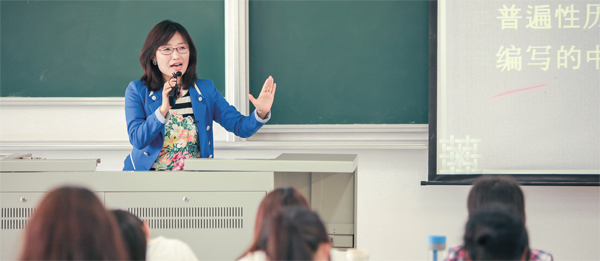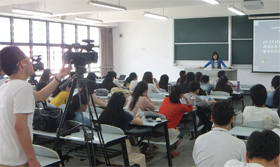동북아역사재단 2013년 07월호 뉴스레터
- Written by Woo Sung-min, Research Fellow at NAHF Office of Policy Planning

To carry out the nationwide 'Education Promotion Plan Toward the 21st Century,' China launched the '211 Project' in 1990 by which about 100 universities would be selected for development. Since 1998, China has been also carrying out the '985 Project' by which additional 30 universities were selected as part of the program geared to create the world's first-class universities. It is said that for young Chinese today the key to landing a job is a diploma from one of the universities belonging to the '985 Project.' I was invited to give a special lecture at the Department of History of East China Normal University (ECNU) in Shanghai, one of these '985' universities. This visit allowed me to realize the importance of communication between Korea and China.
As part of its annual program that invites scholars overseas, the NAHF had an academic exchange with Professor Biao Yang (.彪) of history at ECNU. Although the exchange was brief, it was long enough to improve his impression of Korea and motivate him to start doing something that would increase exchanges with Korea. Once he returned to China, Yang immediately set up a short-term visit program for special lecture and started inviting NAHF research fellows.
Special Lecture on the 'Status of History Education in Korea'
Recently, I was invited to this program and asked to speak on 'Introduction to the Status of History Education in Korea.' To speak on such a grand topic, I needed to understand how the educational system had evolved from the late 19th century to the 21st century. To avoid speaking about what they might already know, I first went over the papers already published in the Chinese academia.
As a good example, a 1998 paper entitled 'History Education in Korea' dealt with the status and characteristics of history education in Korea from 1946 to 1992. This paper gave a summary of how American education style had been introduced into Korea in 1946 onward in order to remove the influence of Japan's colonial rule, and how history, geography, and civics had been incorporated into social studies by the early 1970s, and how Korean History was separated from Social Studies as a single subject in the early 1970s in order to further reinforcing national spirit education. And it described Korea as a country that places emphasis on history education.
As another example, a paper entitled 'How Korean History Is Taught in Korea as Part of Social Studies Curriculum' published in 2003 in Global Education and its Prospect summarized the characteristics of history education in Korea, and presented a view that Korean history education in Korea showed respect for the history of other countries, placed national history in relative perspectives, and covered world history based on Korean history. But it pointed out that Gija Joseon was utterly denied, and saw that self-sufficient national sentiment was strongly expressed. While it showed respect for the Korean academia in some of the descriptions, it perceived Korean history and culture as imitation of Chinese counterpart, and pointed out that the Korean academia's claim on the illegitimacy of Gija Joseon was twisted. This confirmed me the limitations of Chinese academia's perception of Korean history.
As I reviewed these papers, I felt a heavy heart and a great sense of mission; the curriculum of history education in Korea went through several reforms from 2007 onward because of China's Northeast Project and Japan's distorted history textbooks, and it was my job to explain the status of history education in Korea in a limited time to the future historians and history teachers in China while helping them better understand Korean history and culture and fixing their distorted view of Korean history.
About 100 Graduate Students of History Attend the Special Lecture
While I was making a syllabus that would offer a summary of the history of history education in modern and contemporary Korea and translating it into Chinese, May 13th, the day scheduled for special lecture, approached.
My lecture was attended by over 100 students including graduate students of history, and recorded on Chaoxing (超星), a website that services lecture videos by university professors across China.


I started my lecture with the 1st curriculum period (1946-1954) in which Social Studies in Colorado were introduced into Korea, and then I went on to summarize the characteristics of curriculum by period up to the 7th period (1997-2007) in which Korean Modern/Contemporary History had been separated from Korean History in as part of the efforts to differentiate from the previous curricula and seek major changes in curriculum structure and operation. I went into detail about the reform of curriculum from 2007 to 2011 because some of it had not been properly introduced to China yet.
Specifically, I highlighted the establishment of East Asian History as a new subject designed to resolve historical conflicts among East Asian countries, and lay a foundation for peace and prosperity in East Asia through forward-looking history education. I also explained the objectives of this subject; with the East Asian region as a single unit of history, this subject holistically explores what East Asians have in common in their cultural achievements and how these achievements relate to one another in order to engage students actively in development and peace building in the region.
When I mentioned the Northeast Project while explaining how neighboring countries had distorted history, some of the students flushed. But when I talked about various activities by the Northeast Asian History Foundation committed to historical reconciliation and peace in East Asia, they brightened up and actively participated in the Q&A session. After the lecture, some of the students came up to me and asked me questions. One particularly memorable question was about the rumor he said was circulating online in China about how 'Koreans thought that Confucius was Korean and Baekje had occupied China.' My answer was that such a rumor arose because Korea and China didn't understand each other well enough. If such a rumor spread, I said, it could spark anti-Korean and/or anti-Chinese sentiment. Therefore, both Korea and China should work harder to learn about the history and culture of the other country, and be careful in using SNS. Answering the student's question made me feel quite liberating. I wrapped it up by stressing that I hoped that East Asian History as a new subject would increase mutual understanding among the three East Asian countries, and contribute to overcoming the conflict that resulted from history textbooks.
Badly Needed Communication Between Korea and China Through Academic Exchange
After I finished, Professor Yang Biao (.彪) expressed his gratitude to me a number of times, saying that those students who attended my special lecture would have a good impression of Korea, which would be quite influential. When I said at the beginning of the lecture that Sino-Korean relations would develop amicably in proportion to the amount of effort made to understand the other country, many students nodded their head probably because my first-hand experience resonated with them. The students' enthusiastic response to this special lecture got me thinking again about Sino-Korean relations. I think that the Chinese academia's limited perception of Korean history and the Chinese netizens' anti-Korean sentiment may be blamed on the lack of communication between the two countries. Fortunately, both countries seem to agree to the importance of communication.
I hope to see more opportunities for communication between Korea and China so that they will respect each other as neighbors.


